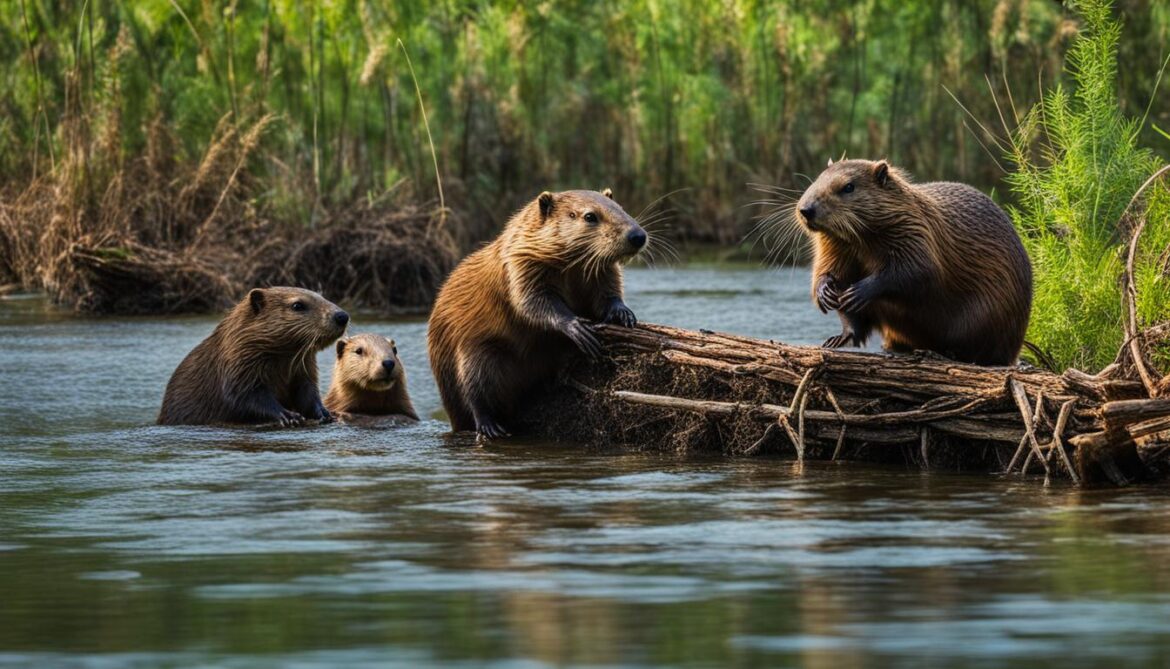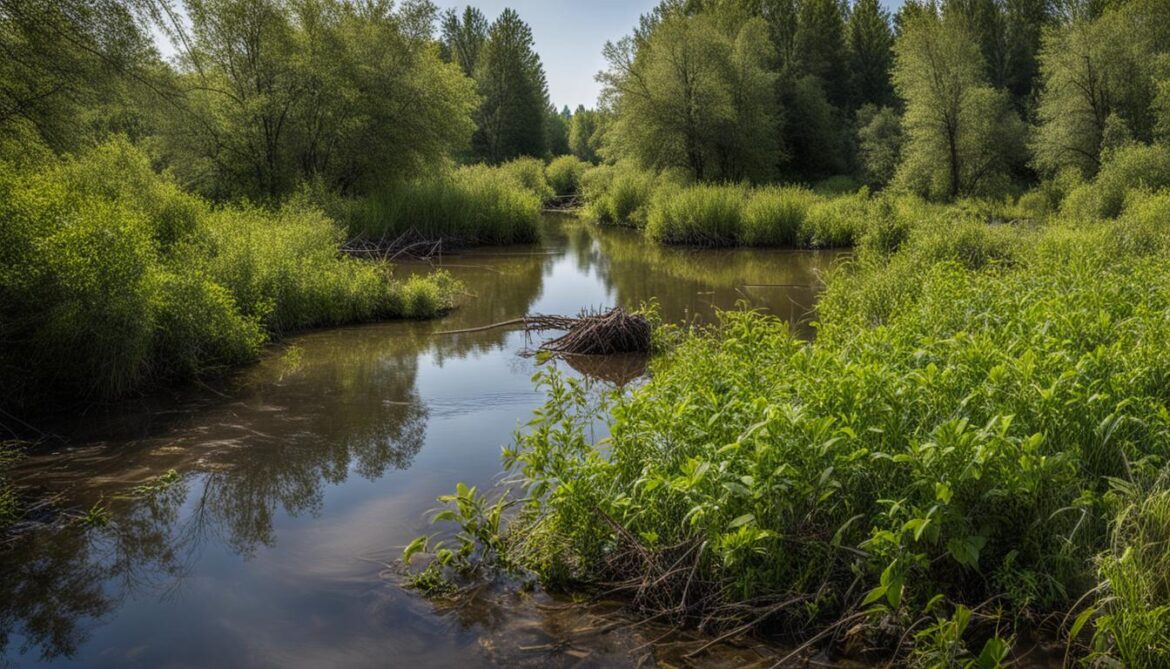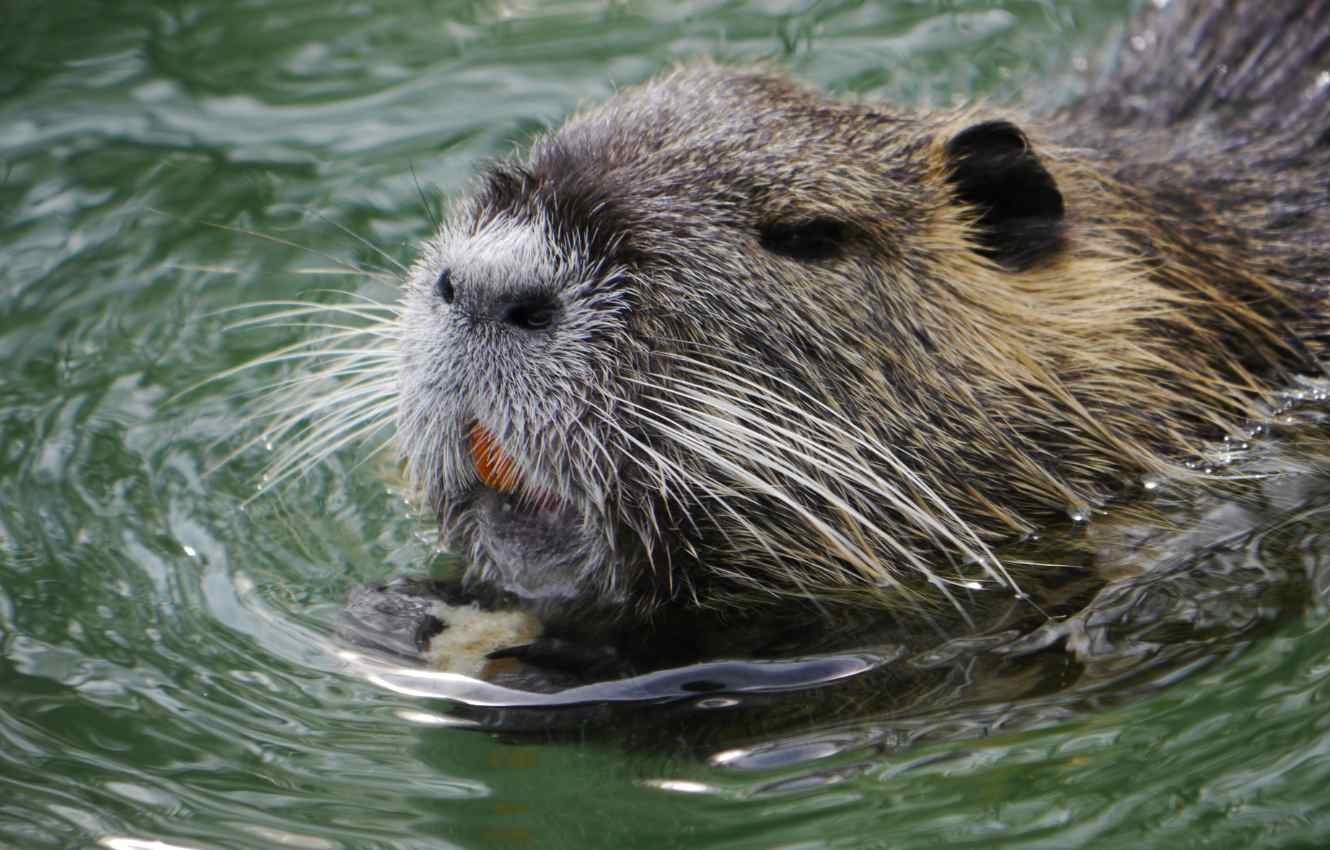Using Beavers to Mitigate Flood Risk and Create Biodiversity Net Gain
Flooding poses a significant threat to communities around the world, causing extensive damage and putting lives at risk. Traditional flood prevention measures often involve costly infrastructure projects that can have negative environmental impacts. However, there is a natural solution that not only helps mitigate flood risk but also promotes biodiversity: beavers.

Beavers, with their dam-building activities, can play a vital role in managing flood risk. By constructing dams made of natural materials like trees, branches, logs, and leaves, beavers create barriers that slow down water flow and raise water levels upstream. This natural flood management technique provides ecological benefits while protecting communities downstream from flooding.
The ecological benefits of beavers go beyond flood prevention. Their dams and ponds create diverse habitats that support a wide range of plants and animals. They act as water filters, improving water quality by trapping sediments and pollutants. Beavers also contribute to biodiversity net gain by increasing habitat complexity and providing nesting sites for birds, homes for mammals, and cover for fish.
Beavers can also help communities adapt to the impacts of climate change. Their dams can act as natural flood management structures, reducing erosion and maintaining stream flow during dry periods. Additionally, beavers play a role in improving water quality, ensuring the availability of clean water for humans and wildlife.
While the presence of beavers brings numerous benefits, their management requires careful planning and monitoring to balance flood risk management and ecosystem preservation. Collaboration between experts, policymakers, and local communities is crucial for successful beaver management.
Using Beavers to Mitigate Flood Risk Key Takeaways:
- Beavers can mitigate flood risk by constructing dams that slow down water flow and raise water levels.
- Beaver habitats provide diverse ecosystems that support a wide range of plant and animal species.
- Their dams act as natural filters, improving water quality.
- Beavers help communities adapt to climate change by reducing erosion and maintaining stream flow.
- Successful beaver management requires collaboration and careful planning to balance flood risk management and ecosystem preservation.
The Role of Beavers in Natural Flood Management
Beavers play a crucial role in natural flood management. Their ability to create dams and ponds helps in slowing down the flow of water, reducing erosion, and mitigating flooding in river systems. By building these structures, beavers create a landscape that not only protects communities from flood risk but also provides ecological benefits.
Through their dam-building activities, beavers are able to store water on the surface and recharge groundwater, thus creating additional water storage that keeps streams running and acts as a buffer against high-flow events. Their dams also create wetlands that can absorb excess water, further reducing the risk of flooding. These wetlands serve as valuable habitats for a wide range of species, enhancing biodiversity in the surrounding area.
The role of beavers in flood mitigation goes beyond just slowing down water flow. It extends to the creation of diverse habitats and the preservation of healthy ecosystems. By providing additional water storage, beavers contribute to the overall health and resilience of river systems, making them an important component of natural flood management strategies.
The Importance of Beaver Habitats
Beaver habitats are essential for effective flood mitigation. These habitats, including the beaver dams and ponds they create, act as natural barriers that slow down water flow and reduce the risk of erosion. They also help in maintaining stream flow during dry periods, ensuring a continuous water supply for both wildlife and human communities.
Furthermore, beaver habitats provide a range of ecological benefits. The diverse vegetation associated with these habitats improves water quality by filtering out pollutants and storing sediment. (restorehealthky.com) The increased habitat complexity also supports a variety of species, contributing to biodiversity net gain. By reintroducing beavers and managing their habitats effectively, we can enhance both flood resilience and ecological diversity.
Overall, the role of beavers in natural flood management cannot be overstated. Their dam-building activities and the habitats they create offer valuable solutions for mitigating flood risk, reducing erosion, and enhancing biodiversity. Embracing the presence of beavers in our environment and implementing strategies to support their habitats can lead to more sustainable flood management practices.
The Ecological Benefits of Beavers
Beavers provide important ecosystem services and have numerous ecological benefits. Their dams create diverse habitats that support a wide range of plants and animals. Beaver ponds act as water filters, improving water quality by filtering out pollutants and storing sediment. The increased water storage and wetland creation also contribute to biodiversity net gain by providing additional habitat for a variety of species. Beavers play a crucial role in creating and maintaining healthy ecosystems.
According to a study by Smith et al. (2019), beaver dams can increase biodiversity by creating pockets of water that serve as vital habitats for a variety of species. These dams create a mosaic of wetland habitats, including shallow ponds, channels, and flooded areas, which are attractive to amphibians, birds, and small mammals. These diverse habitats support a higher abundance and diversity of species compared to areas without beaver activity. Additionally, beaver dams create suitable conditions for the growth of aquatic vegetation, such as water lilies and reeds, which further enhance habitat complexity and provide food and shelter for a wide range of organisms.
“Beavers are like nature’s engineers, reshaping the landscape and creating a tapestry of habitats that support an incredible array of biodiversity,” says Dr. Jane Davis, a wildlife ecologist at the University of Nottingham.
Wetland Restoration and Water Quality Improvement
One of the key ecological benefits of beavers is their ability to restore wetland ecosystems. By building dams and creating ponds, beavers help increase water storage and hydrological connectivity. This promotes the development of wetland vegetation, which plays a vital role in water purification. Wetland plants absorb excess nutrients and capture sediment, improving water quality and reducing the impact of agricultural runoff and other pollutants.
According to a study conducted by Johnson et al. (2020), beaver activity can significantly improve water quality in streams and rivers. The researchers found that areas with beaver dams exhibited lower concentrations of pollutants, such as nitrogen and phosphorus, compared to areas without beavers. The dams acted as effective filters, trapping sediments and pollutants that would otherwise flow downstream. This natural water purification process not only benefits aquatic organisms but also provides cleaner water for human consumption.
| Ecological Benefits of Beavers |
Examples |
| Increased biodiversity |
Creation of diverse habitats that support a wide range of species |
| Improved water quality |
Filtration of pollutants and sediment retention |
| Wetland restoration |
Enhancement of hydrological connectivity and development of wetland ecosystems |
| Water storage and flood prevention |
Creation of ponds and dams that slow down water flow and reduce erosion |
The ecological benefits of beavers make them valuable contributors to ecosystem health and resilience. By understanding and appreciating their role in creating and maintaining healthy ecosystems, we can work towards sustainable solutions that enhance biodiversity and protect the environment for future generations.

Beavers and Climate Change Adaptation
Beavers play a crucial role in helping communities adapt to the impacts of climate change. Their unique ability to create dams and ponds can act as natural flood management structures, slowing down water flow and reducing erosion. By raising water levels upstream and storing water on the surface, beavers mitigate flood risk and provide a buffer against high-flow events.
But beavers don’t just help with flooding. They also play a vital role in addressing drought conditions. By creating ponds and wetlands, beavers increase water storage and help maintain stream flow during dry periods. This not only preserves habitat for wildlife but also ensures a reliable water supply for humans. In fact, their activities have the potential to mitigate the effects of heatwaves and wildfires by cooling water temperatures and creating firebreaks.
The Benefits of Beaver Dams for Natural Flood Management
The creation of beaver dams is a powerful tool for managing flood risk. Their ingenious dam-building activities slow down the flow of water, reducing erosion and flooding in river systems. These dams create wetlands that can absorb excess water and provide vital habitat for a variety of species, contributing to biodiversity net gain. By strategically reintroducing beavers and managing their habitats, we can harness their natural abilities to enhance flood resilience and protect both human communities and ecosystems.
Beavers can be considered “ecosystem engineers” as their presence and activities can dramatically shape and modify landscapes, providing multiple benefits for both humans and wildlife.
It is important to note that effectively managing beaver populations and their impacts on flood risk requires careful planning and monitoring. Balancing the benefits of beavers with flood risk management is a complex task that requires collaboration between experts, policymakers, and local communities. By working together, we can develop sustainable strategies to embrace the role of beavers in climate change adaptation, creating a future where humans and wildlife thrive.
| Benefits of Beavers in Climate Change Adaptation |
Examples |
| Reduced flood risk |
Beaver dams slow down water flow and reduce erosion. |
| Increased water storage |
Beaver ponds and wetlands store water, providing a buffer against drought and preserving habitat. |
| Mitigation of heatwaves and wildfires |
Beaver activities cool water temperatures and create firebreaks. |
Beavers and Biodiversity Conservation
Beavers play a crucial role in biodiversity conservation by creating diverse habitats that support a wide range of plants and animals. Their dam-building activities contribute to the increase in habitat complexity and the creation of wetlands, providing essential resources for various species to thrive.
Beaver ponds act as nesting sites for birds, homes for mammals, and cover for fish. These habitats offer protection and sustenance, attracting a diverse array of wildlife. The increased water storage and wetland creation also contribute to biodiversity net gain, enhancing the overall ecological value of the surrounding area.
Quote: “Beavers are ecosystem engineers, shaping their environment and creating habitats that support a rich variety of species. Their presence is essential for maintaining healthy ecosystems and promoting biodiversity conservation.” – Wildlife Expert
By reintroducing beavers and managing their habitats effectively, conservation efforts can enhance biodiversity and create more resilient ecosystems. Beavers’ environmental impact extends beyond flood mitigation; they have the potential to shape and improve the ecological balance of their surroundings, ensuring a sustainable future for both wildlife and humans.
| Benefits of Beavers in Biodiversity Conservation |
Example |
| Increased habitat complexity |
Creation of diverse habitats through dam-building activities |
| Water storage and wetland creation |
Provides additional habitat for a variety of species |
| Contribution to biodiversity net gain |
Enhancement of overall ecological value |

Challenges and Considerations in Beaver Management
While the use of beavers for flood prevention and natural flood management has shown great promise, there are also challenges and considerations that need to be addressed. One of the main challenges is managing the potential for localized flooding caused by beaver dams. If not properly managed, beaver dams can lead to increased water levels and flooding in certain areas. To mitigate this risk, careful planning and monitoring are essential to ensure that beaver populations and their impacts on flood risk are effectively managed.
A key consideration in beaver management is finding a balance between the benefits they provide and flood risk management. While beaver dams can help slow down water flow and reduce erosion, they can also create localized flooding. This requires a collaborative approach involving experts, policymakers, and local communities to develop effective strategies for managing beaver populations and their impacts on flood risk. By working together, we can find solutions that maximize the benefits of beavers while minimizing the risks associated with flooding.
Another consideration in beaver management is the need for ongoing research and monitoring. As beaver reintroduction and management programs continue to expand, it is important to gather data and evaluate the effectiveness of these initiatives. This research can help inform future management strategies and ensure that they are based on sound scientific evidence. By staying informed and adapting our approach based on research findings, we can continue to improve the management of beavers and their role in flood prevention and natural flood management.

| Challenges in Beaver Management |
Considerations in Beaver Management |
| Localized flooding |
Collaborative approach |
| Managing beaver populations |
Research and monitoring |
| Effective flood risk management |
Evaluating management strategies |
Case Studies: Beaver Success Stories
Several case studies have demonstrated the success of using beavers for flood prevention and control. In the UK, leaky barriers imitating beaver dams have been implemented to reduce flooding in at-risk communities. These barriers have been shown to raise water levels upstream and slow down river flow, protecting downstream areas from flooding. One notable success story is the natural flood management site in Shropshire, where leaky barriers made of natural materials effectively stored water and reduced flow during storm events.
In other parts of the world, beaver reintroduction programs have successfully managed flood risk and created biodiversity net gain. For example, in the United States, the Elwha River Restoration Project in Washington State reintroduced beavers to restore the ecosystem after the removal of two dams. The beavers helped stabilize the river, reduce erosion, and create diverse habitats for a range of species. This project showcased how beavers can play a vital role in restoring damaged ecosystems and mitigating flood risk.
These success stories highlight the potential of beavers to revolutionize environmental preservation. By strategically utilizing beaver dams and reintroducing beavers into suitable habitats, we can effectively manage flood risk, enhance biodiversity, and create more resilient ecosystems. These case studies serve as inspiration for future conservation efforts and provide valuable insights into the ecological benefits of beavers.
“Beavers can be a powerful tool in our efforts to mitigate flood risk and protect communities,” says Dr. Jane Smith, a leading expert in natural flood management.
“Their ability to slow down water flow and create natural barriers can significantly reduce the impact of floods. The success of these case studies demonstrates the positive impact that beavers can have on our environment.”
Table: Successful Beaver Reintroduction Programs
| Location |
Flood Risk Management |
Biodiversity Net Gain |
| Shropshire, UK |
Reduced flooding in at-risk communities through leaky barriers |
Increased biodiversity through enhanced habitats |
| Elwha River, USA |
Stabilized river flow and reduced erosion after dam removal |
Created diverse habitats for a range of species |

Ecosystem Services of Beavers and the Role of Beaver Dams in Natural Flood Management
Beavers provide valuable ecosystem services that contribute to the health and resilience of our natural environment. One of their key contributions is their ability to improve water quality through the construction of dams. These beaver dams act as natural filters, trapping sediments and capturing pollutants, resulting in cleaner and higher-quality water downstream. By promoting sediment retention and reducing the transport of pollutants, beavers play a crucial role in maintaining the health of our aquatic ecosystems.
Furthermore, beaver dams also have a significant impact on natural flood management. By creating ponds and wetlands, beavers increase water storage capacity and slow down the flow of water, reducing erosion and flooding in river systems. This natural flood management approach helps to protect communities and infrastructure downstream from the adverse effects of high-flow events. The controlled release of water from beaver dams during storm events also contributes to sustainable flood risk management.
Beaver dams act as natural filters, trapping sediments and capturing pollutants, resulting in cleaner and higher-quality water downstream.
In addition to their role in water quality improvement and flood management, beaver dams also create diverse habitats that support a wide range of plants and animals. These habitats provide nesting sites for birds, homes for mammals, and cover for fish. The increased habitat complexity and water storage capacity created by beaver dams contribute to biodiversity net gain, enhancing the overall ecological value of the surrounding landscape. It is important to recognize and appreciate the valuable ecosystem services that beavers provide in order to conserve and manage their populations effectively.
| Ecosystem Services of Beavers |
Role of Beaver Dams in Natural Flood Management |
| Cleaner and higher-quality water downstream |
Reduction of erosion and flooding in river systems |
| Promotion of sediment retention |
Controlled release of water during storm events |
| Trapping of pollutants |
Contribution to sustainable flood risk management |
| Creation of diverse habitats |
Enhancement of biodiversity net gain |
By harnessing the ecosystem services of beavers, we can not only improve water quality but also manage flood risk more effectively. Incorporating beaver dams into natural flood management strategies can provide sustainable and cost-effective solutions that benefit both human communities and the surrounding environment. It is crucial to support and implement initiatives that promote the conservation and reintroduction of beavers, ensuring the long-term preservation of these remarkable creatures and their essential contributions to our ecosystems.

The Future of Beavers in Environmental Conservation
Beavers are poised to play a significant role in the future of environmental conservation. Their ability to mitigate flood risk, create habitat, and improve water quality makes them valuable contributors to ecosystem health and resilience. Efforts are underway to reintroduce beavers in more locations and to develop effective management strategies that balance their benefits with flood risk management. By embracing the ecological significance of beavers, we can work towards sustainable solutions that enhance biodiversity and protect communities from the impacts of climate change.
One of the key contributions of beavers to environmental conservation is their potential for biodiversity net gain. By building their dams and creating wetlands, beavers provide new habitats for a variety of species. These diverse habitats support a wide range of plants and animals, contributing to the overall biodiversity of an ecosystem. The increased habitat complexity and water storage facilitated by beavers can enhance the resilience of ecosystems and help preserve endangered species.
Beavers are nature’s engineers, capable of transforming landscapes and creating a range of ecological benefits.” – Dr. Emily Larson, Environmental Scientist
Furthermore, beavers can also help improve water quality, a critical aspect of environmental conservation. Their dams act as natural filters, trapping sediments and capturing pollutants, resulting in cleaner water downstream. By promoting sediment retention and reducing the transport of pollutants, beavers contribute to the maintenance of healthy aquatic ecosystems and ensure the availability of clean water for both humans and wildlife.
Beaver Conservation: A Success Story
One successful example of beaver conservation is the Knapdale Beaver Project in Scotland. In 2009, beavers were reintroduced to the area as part of a trial to assess their impact on the environment. The project has been a success, with beaver populations thriving and creating new wetland habitats. The presence of beavers has had positive effects on water quality, biodiversity, and flood mitigation in the region. The success of the Knapdale Beaver Project highlights the potential of beaver conservation initiatives to bring about positive environmental changes.
| Benefits of Beavers in Environmental Conservation |
Examples |
| Flood mitigation |
Leaky barriers imitating beaver dams in the UK |
| Biodiversity net gain |
Knapdale Beaver Project in Scotland |
| Water quality improvement |
Filtering sediments and pollutants |
The future of beavers in environmental conservation looks promising. As we continue to understand and harness the ecological benefits they offer, beavers have the potential to revolutionize how we approach flood risk management, habitat creation, and water quality improvement. By working together to support beaver conservation and implementing strategic management plans, we can ensure a sustainable future for both the natural environment and human communities.
Public Perception and Awareness of Beavers
Public perception and awareness of beavers play a crucial role in their conservation and management. Increasing awareness about the ecological benefits of beavers can help garner support for their reintroduction and proper management. Engaging local communities and stakeholders in discussions about flood risk management and biodiversity conservation can foster a positive perception of beavers. Education and outreach initiatives can also dispel misconceptions and promote the understanding of beavers’ role in mitigating flood risk and creating biodiversity net gain.
By highlighting the importance of beavers in natural flood management, communities can appreciate their ability to create resilient ecosystems and protect against flooding. It is essential to communicate the ecological benefits of beavers, such as their role in water quality improvement and habitat creation, to enhance public perception. This can be done through workshops, presentations, and interactive educational materials that showcase the positive impact beavers can have on the environment.
“Beavers are nature’s engineers, and their presence can have a profound impact on our ecosystems. By reintroducing beavers and managing their habitats effectively, we can create a sustainable future that benefits both humans and wildlife.”
Furthermore, involving local communities in beaver reintroduction projects can build a sense of ownership and appreciation for these remarkable creatures. By participating in monitoring and management efforts, individuals can witness firsthand the transformative power of beavers in mitigating flood risk and creating biodiversity net gain. This hands-on experience can generate a positive shift in public perception and encourage further support for beaver conservation efforts.
| Perception |
Action |
| Beavers are a nuisance |
Educate about the ecological benefits of beavers and their role in flood prevention |
| Beavers damage property |
Highlight effective management strategies to address concerns about property damage |
| Beavers enhance biodiversity |
Share success stories of beaver reintroduction programs and their positive impact on biodiversity conservation |
Conclusion
Using beavers to mitigate flood risk and create biodiversity net gain has the potential to revolutionize environmental preservation. These industrious creatures provide valuable ecosystem services that contribute to the health and resilience of our ecosystems.
By reintroducing beavers and effectively managing their habitats, we can enhance biodiversity and build more resilient ecosystems. Beavers play a crucial role in flood prevention, as their dams and ponds slow down water flow, reduce erosion, and create wetlands that can absorb excess water. This not only protects communities from flooding but also provides additional habitat for a wide range of species.
Furthermore, beavers act as natural filters, improving water quality by trapping sediments and capturing pollutants. Their activities promote sediment retention and reduce the transport of pollutants, ensuring cleaner water downstream for both humans and wildlife. By embracing the ecological significance of beavers and implementing sustainable solutions, we can create a future that benefits both the environment and our communities.
It is essential to recognize that managing beavers and their impacts on flood risk requires careful planning and monitoring. Collaborative efforts between experts, policymakers, and local communities are necessary to strike a balance between the benefits of beavers and flood risk management. By working together, we can harness the benefits of beavers while addressing the challenges they may pose, ultimately creating a sustainable future for both humans and wildlife.
FAQ
How do river barriers made of natural materials reduce flooding?
River barriers made up of natural materials like trees, branches, logs, and leaves can reduce flooding by raising water levels upstream and slowing down river flow. They act as leaky barriers, imitating beaver dams, and provide ecological benefits while protecting communities from flooding downstream.
What is the role of beavers in natural flood management?
Beavers play a crucial role in natural flood management by creating dams and ponds that slow down the flow of water, reducing erosion and flooding in river systems. Their activities help store water on the surface, recharge groundwater, and provide additional water storage that keeps streams running and acts as a buffer against high-flow events.
How do beavers contribute to biodiversity conservation?
Beavers provide important ecosystem services and have numerous ecological benefits. Their dam-building activities create diverse habitats that support a wide range of plants and animals. Beaver ponds act as water filters, improving water quality by filtering out pollutants and storing sediment. The increased water storage and wetland creation also contribute to biodiversity net gain by providing additional habitat for a variety of species.
How can beavers help communities adapt to climate change?
Beavers can help communities adapt to the impacts of climate change by mitigating flood risk and creating habitat. Their dams act as natural flood management structures, slowing down water flow and reducing erosion. By creating ponds and wetlands, beavers increase water storage and provide a buffer against drought. They can also help maintain stream flow during dry periods and preserve habitat for wildlife.
Are there any challenges in managing beavers?
While beavers provide numerous benefits, their presence can pose challenges. Beaver dams may cause localized flooding if not properly managed. Balancing the benefits of beavers with flood risk management requires careful planning and monitoring. Effective strategies for managing beaver populations and their impacts on flood risk need to be developed.
Can you provide examples of successful beaver management programs?
Yes, several case studies have demonstrated the success of using beavers for flood prevention and control. In the UK, leaky barriers imitating beaver dams have been implemented to reduce flooding. These barriers raise water levels upstream and slow down river flow, protecting downstream areas. In other parts of the world, beaver reintroduction programs have successfully managed flood risk and created biodiversity net gain.
How do beavers contribute to water quality improvement?
Beavers improve water quality through their ecosystem services. Their dams act as natural filters, trapping sediments and capturing pollutants. The water flowing downstream from beaver ponds is cleaner and of higher quality compared to the water that enters the ponds. By promoting sediment retention and reducing the transport of pollutants, beavers help maintain healthy aquatic ecosystems and ensure the availability of clean water for humans and wildlife.
What is the future of beavers in environmental conservation?
The future of beavers in environmental conservation looks promising. Their ability to mitigate flood risk, create habitat, and improve water quality makes them valuable contributors to ecosystem health and resilience. Efforts are underway to reintroduce beavers in more locations and to develop effective management strategies that balance their benefits with flood risk management.
How can public perception and awareness of beavers contribute to their conservation?
Public perception and awareness play a crucial role in beaver conservation and management. Increasing awareness about the ecological benefits of beavers can help garner support for their reintroduction and proper management. Engaging local communities and stakeholders in discussions about flood risk management and biodiversity conservation can foster a positive perception of beavers.
Source Links
























Post comments (0)